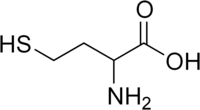
Photo from wikipedia
We were pleased to read the nice and elegant article by Dr. Çandar and coworkers [1]. that is recently published in your journal offering the protective effect of folic acid… Click to show full abstract
We were pleased to read the nice and elegant article by Dr. Çandar and coworkers [1]. that is recently published in your journal offering the protective effect of folic acid supplementation on ischemia/reperfusion (I/R) injury of ovaries. This paper piqued our interest from a number of perspectives because of providing a wealth of information especially on understanding the multifaceted anti-oxidative role of folic acid in I/R injury. Although the authors discussed the results of their findings comprehensively, we would like to add several additional comments and offer a few suggestions for consideration. Folic acid, known as vitamin B9, is the oxidized form of folate available in fortified food and supplements as it cannot be synthesized by mammals and must be acquired via dietary ingestion [2]. It acts as a coenzyme in many important one‐ carbon metabolic reactions and associated with increases in circulating plasma homocysteine levels and reduction in DNA methylation patterns ultimately resulting in genome instability events [3]. The antioxidant effect of folic acid is mediated via multiple pathways, including a reduction in serum homocysteine concentrations, which may increase total antioxidant capacity and reduce reactive oxygen species (ROS) formation. As also mentioned by the authors in the discussion section of the manuscript folic acid is needed as a cofactor for proper homocysteine enzyme functioning and its supplementation reduce the serum homocysteine levels significantly. Unfortunately, there is no information on the rest of the manuscript regarding the serum concentrations of homocysteine and its correlation with folic acid and oxidative stress markers. Therefore, it can be speculated that decreased oxidative stress by folic acid supplementation might have been resulted from homocysteine linked effects including reduced cellular and protein injury and decreased production of reactive oxygen species. One other shortcoming of the study is the lack of evaluation of wellknown oxidative stress markers such as malondialdehyde (MDA), glutathione (GSH) and nitric oxide (NO). We have to acknowledge that folic acid supplementation is associated with decreased MDA and NO and increased GSH concentrations in distinct disease states [4]. Therefore, we think that in a study evaluating the role of folic acid supplementation on a rat ovarian I/R injury model, determining the serum concentrations of homocysteine, MDA, GSH and NO could be noteworthy in the context of this close relationship. In conclusion, although this study provides substantial evidence on the role of folic acid supplementation on ovarian I/R injury, it must be noted that serum homocysteine concentrations could also be related to the final outcome.
Journal Title: Archives of Gynecology and Obstetrics
Year Published: 2022
Link to full text (if available)
Share on Social Media: Sign Up to like & get
recommendations!